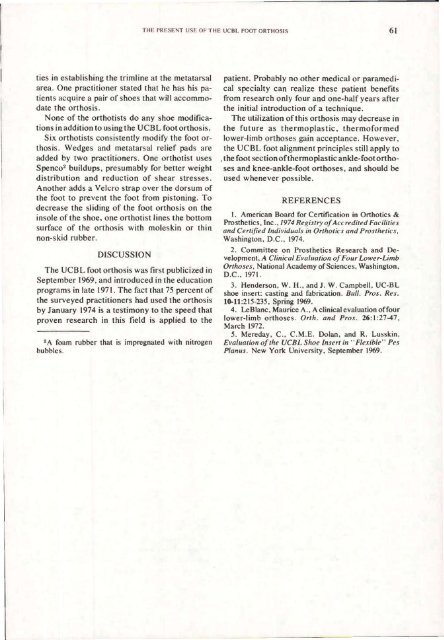Orthotics and Prosthetics
Orthotics and Prosthetics
Orthotics and Prosthetics
Create successful ePaper yourself
Turn your PDF publications into a flip-book with our unique Google optimized e-Paper software.
ties in establishing the trimline at the metatarsal<br />
area. One practitioner stated that he has his patients<br />
acquire a pair of shoes that will accommodate<br />
the orthosis.<br />
None of the orthotists do any shoe modifications<br />
in addition to using the UCBL foot orthosis.<br />
Six orthotists consistently modify the foot orthosis.<br />
Wedges <strong>and</strong> metatarsal relief pads are<br />
added by two practitioners. One orthotist uses<br />
Spenco* buildups, presumably for better weight<br />
distribution <strong>and</strong> reduction of shear stresses.<br />
Another adds a Velcro strap over the dorsum of<br />
the foot to prevent the foot from pistoning. To<br />
decrease the sliding of the foot orthosis on the<br />
insole of the shoe, one orthotist lines the bottom<br />
surface of the orthosis with moleskin or thin<br />
non-skid rubber.<br />
DISCUSSION<br />
The UCBL foot orthosis was first publicized in<br />
September 1969, <strong>and</strong> introduced in the education<br />
programs in late 1971. The fact that 75 percent of<br />
the surveyed practitioners had used the orthosis<br />
by January 1974 is a testimony to the speed that<br />
proven research in this field is applied to the<br />
*A foam rubber that is impregnated with nitrogen<br />
bubbles.<br />
patient. Probably no other medical or paramedical<br />
specialty can realize these patient benefits<br />
from research only four <strong>and</strong> one-half years after<br />
the initial introduction of a technique.<br />
The utilization of this orthosis may decrease in<br />
the future as thermoplastic, thermoformed<br />
lower-limb orthoses gain acceptance. However,<br />
the UCBL foot alignment principles still apply to<br />
, the foot section of thermoplastic ankle-foot orthoses<br />
<strong>and</strong> knee-ankle-foot orthoses, <strong>and</strong> should be<br />
used whenever possible.<br />
REFERENCES<br />
1. American Board for Certification in <strong>Orthotics</strong> &<br />
<strong>Prosthetics</strong>, Inc., 1974 Registry of Accredited Facilities<br />
<strong>and</strong> Certified Individuals in <strong>Orthotics</strong> <strong>and</strong> <strong>Prosthetics</strong>,<br />
Washington, D.C., 1974.<br />
2. Committee on <strong>Prosthetics</strong> Research <strong>and</strong> Development,<br />
A Clinical Evaluation of Four Lower-Limb<br />
Orthoses, National Academy of Sciences, Washington,<br />
D.C., 1971.<br />
3. Henderson, W.H., <strong>and</strong> J. W. Campbell, UC-BL<br />
shoe insert: casting <strong>and</strong> fabrication. Bull. Pros. Res.<br />
10-11:215-235, Spring 1969.<br />
4. LeBlanc, Maurice A., Aclinical evaluation offour<br />
lower-limb orthoses. Orth. <strong>and</strong> Pros. 26:1:27-47,<br />
March 1972.<br />
5. Mereday, C., C.M.E. Dolan, <strong>and</strong> R. Lusskin,<br />
Evaluation of the UCBL Shoe Insert in "Flexible" Pes<br />
Planus. New York University, September 1969.
















